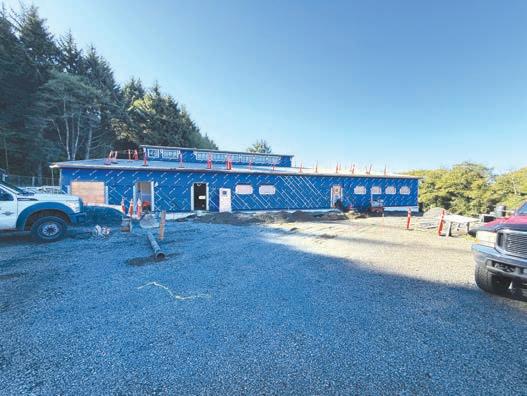






WILL CHAPPELL Gazette Editor
Work on the Cannon Beach city hall and police station projects is progressing smoothly, with the police station still slightly ahead and both are still on schedule and budget.
During a site tour of both projects in mid-Octo -
ber, the Gazette was given an opportunity to see the work and sit in on a project meeting.
The new city hall, located on Gower Street in downtown Cannon Beach, was in the process of having walls erected, with trusses scheduled for delivery shortly and roof installation set to begin work shortly after and work on
designing and budgeting a solar panel system for the building was underway.
Team members said that the first waterproofing barrier for the roof should be installed by November 20, and that the vapor barrier for the rest of the building was being installed currently. Sometime in late

PIERCE BAUGH V for the Gazette
The Cannon Beach Cottage Tour is the grand event for the Cannon Beach History Center & Museum, but just because its big event of the year has passed doesn’t mean the museum is moribund.
“I think that’s what we strive to be, is like that community place for people to come in, even though you just want to say hi,” says Cannon Beach History Center & Museum Executive Director, Liz Scott.
In service of that goal of welcoming the community, the museum has several activities planned this month to help residents stay busy as winter weather rolls in. November is Native American Heritage Month, and Brad Mix, who is of Red River Métis decent, will be speaking as part of The Gathering, Cannon Beach’s annual
celebration for Native American Heritage Month on November 16.
Mix will be sharing his family history with Louis Riel and the Northwest Resistance of 1885, a crucial moment in Métis and Canadian history. Born in Canada in 1954, Mix has a lineage of Métis activists in his blood, like Josephine Sauve, Charles Sauve, and Arsinoe Nault.
Mix says he feels a responsibility to share Métis stories. “I feel a responsibility to share what I’ve learned through personal struggle, ceremony, and family research, so these stories don’t disappear with me, like so many Métis stories already have,” he said.
His conversation will delve into what it means to be of “mixedblood” identity and heritage. Zoe Swain, Cultural Outreach Coordinator at the Cannon Beach History Center & Museum, says, “It’s also
about mixed ancestry more broadly. The question of ‘how Indigenous are you?’ can be deeply painful for many people of mixed heritage. What’s so inspiring about the Métis Nation is how they celebrate being both European and Indigenous, embracing that dual identity as strength, not conflict.”
This free event, “Reclaiming the Mixed Blood Story: A Conversation with Brad Mix (Red River Métis),” will take place on Sunday, November 16, 2025, at 11 a.m. It will be held at the Cannon Beach History Center & Museum, located at 1387 South Spruce Street in Cannon Beach, Oregon. It can be strange being a local in a tourist destination, almost like where you live isn’t optimized for you. Well, this month, Cannon

WILL CHAPPELL Gazette Editor
At the recent opening of the Nehalem Bay Health District’s new clinic and pharmacy in Wheeler, United States Congresswoman Suzanne Bonamici made time for a short press availability to discuss current issues.
In response to a question about the federal government shutdown, Bonamici said that she had been in Washington D.C. the week prior, unlike her Republican colleagues, and was planning to return the next week. Bonamici said that she was interested in working to get the government open again, but not at the cost of jeopardizing constituents’ access to healthcare or increasing the costs of care.
“I am interested in getting the government back open, but I’m not interested in supporting a budget that will result in increases in healthcare costs or people losing their access to healthcare,”

WILL CHAPPELL Gazette Editor
Cannon Beach city council held a special meeting on October 28, to discuss potential paths forward for the Cannon Beach Elementary School property.
At the meeting, Councilors Gary Hayes and Erik Ostrander each presented a plan proposing to demolish the buildings on the site to turn it into a park, including an interpretative trail, weather-sheltered gathering areas, restrooms and parking. Councilors signaled their interest in moving forward with planning a park of some kind, though commenters at the meeting spoke in favor of saving the buildings, especially the gymnasium, to serve as an indoor recreation space for the community.
The discussion about the site’s future follows two votes in the past year complicating the prospects of developing the property.
In the first, after Cannon Beach Together, an advocacy group consisting of local business owners, sued the city over plans to spend $7.8 million on renovating the classroom and gymnasium buildings. To settle the case, the city agreed to hold an advisory vote on the project and in November 2024,
Bonamici said.
On the subject of the Secure Rural Schools Act and resuming the split of federal timber revenues with counties, Bonamici said that while she was aware of the issue, she and congressional colleagues were focused on ending the government shutdown at the moment.
The Federal Emergency Management Agency’s proposed updates to development standards in areas of special flood hazard for Oregon jurisdictions to continue participating in the National Flood Insurance Plan was an issue Bonamici said was on her radar. Bonamici said that the Oregon congressional delegation had sent a joint letter to the agency urging them to slow the process to better account for impacts to Oregon communities.
“We just sent another communication saying you’ve got to



WILL CHAPPELL
Several hundred residents gathered in Wheeler on October 4, for the grand opening of the new Nehalem Bay Health District Clinic and Pharmacy, featuring a ribbon-cutting ceremony and open house.
The new $12.2-million facility will allow the Nehalem Bay Health Center to expand its offerings to include dentistry and mental healthcare and significantly expand its clinic and pharmacy capacities and was supported by a $10.25-million bond approved by voters in 2023.
“We reach a historic milestone today with this new health center and pharmacy,” said Nehalem Bay Health District (NBHD) President Marc Johnson, “with new services, a new and better patient experience, and a wonderful facility for the dedicated healthcare workers who devote themselves to our community. So, I am so please to have so many folks here today.”
Progress toward building the new facility began when NBHD went through a strategic planning process in 2018, which led the district’s board of directors to expand
the district’s mission to include helping with area needs beyond healthcare, including housing. In 2021, that led Tillamook County Commissioner Erin Skaar, then the director of Community Action Resource Enterprises, Tillamook’s homeless services provider, to reach out to Johnson about a property adjacent to Highway 101 in Wheeler.
At first, Skaar thought that the parcel could present an opportunity to add much-needed housing to the community. Initial inquiries showed that it would not be fit for that purpose, but that it would serve as a good home for a new health center.
NBHD was then operating out of a building constructed in the 1980s, which had only six exam rooms and lacked capacity for expansion. NBHD’s board began working on a plan for a new facility and by 2022, had developed an ambitious $15.5-million plan to build the new clinic and pharmacy, majorly renovate the district’s senior care facility in Wheeler and repurpose the old clinic site for affordable housing.
Johnson said that during the development of that plan, community members












asked how the district would pay for the projects, and he told them, “If you can’t envision the final project, you’ll never find a way to pay for it. If the vision is good; you can find the resources.”
The district first secured $3 million in 2022’s federal OMNIBUS spending bill in support of the project as well as an additional $500,000 grant from the federal government. The board then sought voter approval for the $10.25-million bond issue in May 2023, and the measure passed with 69.7% voting in favor. Further support came in from the Oregon Community Foundation, Roundhouse Foundation, Murdoch Charitable Trust, Robert D. and Marcia Randall Charitable Trust, Ford Family Foundation, Sam Wheeler Foundation, Samuel Johnson Foundation, Jeffrey Koslovsky Fund, Fred Cornforth











and Hampton Lumber, which donated $100,000 in lumber to the project.
Work began with a July 2024 groundbreaking ceremony and was led by Bremik Construction, progressing on-schedule and under budget over the past 15 months.
At the ribbon-cutting ceremony, Johnson welcomed the large crowd and thanked them for attending, before welcoming Nehalem Bay Health Center and Pharmacy CEO Gail Nelson to the dais.
Nelson thanked the Health Resources and Services Administration and other contributing foundations for funding furniture for the new facility, which at 16,000 square feet is three times the size of the district’s old facility, and said that the clinic’s used medical equipment was being donated to Ukraine.
Nelson also thanked Dr. Harry Rinehart, a member of the Rinehart family which has practiced medicine in north Tillamook County since 1913 and helped build the hospital that was replaced by the district’s previous clinic, for his commitment. “Today’s the day to celebrate not only a new building, but the people, past and present, who make compassionate healthcare possible in north Tillamook County,” Nelson said.
Johnson then welcomed Wheeler Mayor Denise
Donohue to the dais, thanking her for supporting the project. Donohue said that the new clinic marked a new chapter for the city and north Tillamook County, with easier access to important health services.
“For me, and I believe the city of Wheeler, this center represents far more than bricks and mortar, it represents access, access to better medical care, access to quality dentistry, access to vital mental health services,” Donohue said. “These are not luxuries, these are necessities and today we are celebrating that these services are no longer miles away, out of reach, but here in our home.”
Skaar then addressed the crowd, recounting the history of working with Johnson on identifying the property and lauding the NBHD board for their commitment to the community and the strength of their vision for the project.
Skaar also praised the district’s voters for approving the bond in 2023. “There was a huge commitment that took a phenomenal leap of faith, to pass a bond for $10.25 million in a community of roughly 3,600 people, that’s not done,” Skaar said. “People don’t say I’m willing to tax myself that much for something in my community very often, but this community said, we believe, we believe in the vision, we believe in the
health center, we believe in the clinic, and we’re going to do it.”
Finally, United States Congresswoman Suzanne Bonamici spoke, complimenting the facility and saying that she understood and appreciated the pivotal role NBHD and other rural healthcare providers play in their communities.
“I know that hospitals and clinics like this one here at Nehalem Bay are vital parts of the community and infrastructure and make such a difference, as you’ve heard from the mayor and everyone, not just to the people who live here, but to the economy, to the region,” Bonamici said.
The speakers then gathered with other elected officials including Oregon Secretary of State Tobias Read, State Senator Suzanne Weber and State Representative Cyrus Javadi to cut the ribbon and open the new facility.
Members of the public were then welcomed to self-guided tour of the building, which features a 14-examination-room clinic and 1,400-squarefoot pharmacy downstairs and three operatory dental suite, x-ray room, mental-health treatment room and large community room upstairs. The pharmacy opened on October 6 and the clinic began seeing patients later in the week.

Events From Page A1
Beachers can be hometown tourists. From November 8 to 11, there will be Hometown Tourism Days: Be a Tourist in Your Own Hometown. This multi-day event invites you to explore the best of Clatsop and Pacific counties by being a tourist in your own hometown. Many local sites are teaming up to offer fantastic deals, including free admission, for
this expanded celebration. What started as a single-day promotion is now a multiday opportunity, giving more people the chance to visit more attractions and see what makes the region so special. Be sure to mark your calendar for the Cannon Beach History Center & Museum! On the designated Saturday and Tuesday of the event, you can enjoy free admission from 11 a.m. to 4 p.m. Other participating attractions for Hometown Tourism Days are spread across cities in both Clatsop County, Oregon, and Pacific County, Washington. In Oregon, you can visit sites in Astoria (including the Columbia River Maritime Museum and the Astoria-Warrenton Area Cham-
ber of Commerce Visitor Center) and Seaside (home to the Seaside Aquarium and the Seaside Museum & Historical Society). Across the border in Washington, events are held in Ilwaco (Columbia Pacific Heritage Museum), Long Beach (Cranberry Museum & Gift Shop), and Raymond (Northwest Carriage Museum and Willapa Seaport Museum), as well as the Knappton Cove Heritage Center near the Astoria Bridge. Stop by the museum at 1387 S. Spruce St. to explore the exhibits, enjoy complimentary refreshments, and receive 10% off any purchases in the gift shop. For more information, contact Liz Scott at 503-436-9301 or liz@cbhistory.org.

Work at the police station is ahead of the city hall, with a vapor barrier already installed in mid-October.
From Page A1
November or early December, utility rough-in will be complete and permitting
almost 60% of citizens voted against the project as then-envisioned.
In the second vote this May, voters approved a ballot measure that requires the city to seek voter approval to incur any debt totaling more than 50% of government activity revenues, a figure around $5.9 million currently.
With around $4 million already spent on acquiring the property, removing hazardous materials, replacing the classroom building’s roof and public process, a new approach, substantially different from the proposal that failed last November and with a budget under the new borrowing limit or capable of gaining voter support, is now needed.
At the October meeting, council first welcomed comments from the public, who, by and large, advocated for renovating the buildings to serve as a community center for the city, with several lamenting the lack of available indoor recreation space.
Hayes then presented his plan for the park, which would see the classroom and gym buildings torn down and the natural environment of the area restored. An interpretative path around the park would include opportunities to learn about the native village that was once on the site, as well as the ecological importance of the area. Hayes’s plan also included adding parking and a restroom at the site while keeping the food pantry in its current location, and he said that he would like to see a group picnic shelter or other weather-protective structure included as well.
From Page A1 slow the process down because you don’t understand how this works,” Bonamici said, “particularly here on the Oregon coast.” Finally, in response to a question about Democrats’ message to voters heading into the midterm elections next year, Bonamici said that rising costs would be a primary focus, along with capitalizing on voters’ discontentment with President Donald Trump.
“The overall message is, because we’re hearing that people are really disappointed in what they’re seeing, even people who voted for the current president, is that you deserve better,” Bonamici said.
“I feel that way about the people I represent, it’s like, you deserve better than a government that is going to increase your cost, create economic chaos and take away healthcare.”
for the building’s signage is in progress. At the police department, insulation installation was 80% complete, the roof was a week to two weeks from completion and drywall was being
While the plan still needs significant development, which Hayes suggested should be done in consultation with a professional park designer, Hayes said that the site offered an excellent opportunity to tell the story of the village that once occupied it and the ecology of the area.
In addition to the rough plans for the site, Hayes also detailed available funding sources that could generate up to $6.6 million to finance the project.
The largest source was a $3.46-million bond taken by the city to support the project, with an additional $1.2 million currently available in the restricted transient lodging tax (TLT), $836,000 generated by the TLT annually, $120,000 available annually to the city from the county’s TLT and up to $1 million available from the city’s Tourism and Arts Fund.
Hayes clarified that his plan had no projected budget and that he was responding to criticism that past processes for the site had focused on project design without first identifying a funding mechanism.
Hayes also said that while he heard commenters’

hung. Concrete work at the site was set to begin October 27, and aside from redesigning the building’s sewer line to pass under a domestic water line, everything was going as planned.
desire for a community center, the council needed to remind the public that if it was going to use restricted TLT dollars, any project needed to have a substantial purpose of serving tourists.
Ostrander then discussed his vision for the park, which was similar to that of Hayes. Ostrander’s plan also included knocking down the buildings on the property and an interpretive trail, as well as a heritage and community garden and dog park. Ostrander also imagined the possibility of leaving the current gymnasium’s roof structure standing to create a sheltered area for recreation.
Ostrander said that the different aspects of the park represented options and that what was eventually included would be determined by the price and available funds.
Following the presentations, council began to discuss the issue, with Councilor Lisa Kerr saying that while a lot of people wanted an indoor recreation facility, even more had made it clear they didn’t want to pay for such a facility when they voted it down last November. Kerr said that the council first needed

to decide whether the site should become a park or community center, and Councilor Deanna Hammond agreed that deciding the buildings’ fate needed to be the council’s next step.
Hayes said that it was clear that they were not going to gain public support for funding an indoor option, which had led him to bring forward his plan, but that he did hope that a weather-protected space at the park could serve as a classroom.
A representative from the Clatsop-Nehalem Tribes then spoke, saying that the tribes were honored to be involved in the process and wanted to make sure that whatever the site became, it honored the history of the native people who once lived there.
Parks committee members, who were also at the meeting, were then asked


to weigh in, with opinions split, with two favoring the park proposal, one speaking in favor of a community center and a third saying that they lacked enthusiasm for beginning the process again.
Hayes said that he shared that sentiment but that in crafting his new proposal he had worked to find the common denominators that the community supported for the project, including honoring the tribe and including gathering space.
Councilor Lisa Kerr asked Hayes if he was comfortable deciding to forego an indoor community center at the site and he said yes. Kerr continued that she wanted to see an indoor space for the community but that she didn’t think the site was appropriate because of its tsunami
decision the council made should be put to a vote of a people, but after Hayes, Kerr and Mayor Barbara Knop disagreed, she backed down from the proposal.
Knop voiced a consensus for the council as the meeting wrapped up, saying that she wasn’t interested in going down the election road again and that the elementary school site should be made into a park while further exploration of potential sites for a community center continues.












































PIERCE BAUGH V for
There’s a scene in the 1970 Christmas film, “Scrooge,” where Tiny Tim, played by Richard Beaumont, sings that he’d love to live in a world where the sun shines for him. It’s a moment that’s meant to be endearing, but when ruminated on, Tiny Tim likes to imagine a world where the sun shines for him. Tiny Tim was dealt a rough hand, but, still, he
likes to imagine the sun shining for him. At the risk of sounding scroogey, it’s a tad self-centered of him, isn’t it?
Well, this holiday season, the Coaster Theatre will present A Carol for Tiny Tim. Fifteen years after Scrooge’s transformation of the soul, Tiny Tim, now grown-up, has become a nightmare of the bahhumbig variety himself. Using his past ailment as an excuse to bilk money from his family and friends, it seems Tiny
Tim is due for his own visitation from three Spirits of Christmas Past, Present and Future.
“It’s a really sweet piece,” says Coaster Theatre Executive Director Patrick Lathrop. “It’s got a real similar feel to Scrooge.”
Performances run from November 21 to December 21, 2025. Most evening performances begin at 7:30 p.m., while all Sunday matinees start at 3 p.m. Tickets are priced at $35 and
$30 and can be purchased online, directly at the theatre box office, or by calling 503-436-1242. Note two special evenings: a Pay What You Will performance on Thursday, December 4, and a Fundraiser Performance on Sunday, December 14. There will also be a special children’s choir performance of a combination of Broadway songs and holiday classics on Sunday, Nov. 9, at 3:00 p.m. Tickets cost $10.00.
from 1% to 3%.
On Wednesday, September 10, 2025, the Clatsop County Board of Commissioners adopted an ordinance amending Clatsop County Code 3.16, which governs the County’s
Transient Room Tax. The changes may impact how lodging operators and intermediaries collect and remit this tax beginning in 2026. A copy of the amended ordinance is available online at: www.clatsopcounty. gov/assessment/page/tran-
sient-room-tax
Key Changes Countywide Tax Increase
Effective January 1, 2026, the Countywide Transient Room Tax will increase
Transient Lodging Tax Collectors are required to collect and remit 3% of the rent charged for occupancy of transient lodging within Clatsop County. This increase is in addition to existing unincorporated County, City, and State lodging tax rates.
Updated Definition of “Transient Lodging Intermediary”
The updated ordinance clarifies that a Transient Lodging Intermediary is any person or entity other than the lodging provider that facilitates the retail sale of lodging and either:
• Charges for occupancy of the transient lodging;
• Collects the consideration charged for occupancy of the transient lodging; or
• Receives a fee or commission and requires the transient lodging provider to use a specified thirdparty entity to collect the consideration charged for occupancy of the transient lodging.









Responsibility
The Transient Lodging Tax Collector directly receiving payment for occupancy is responsible for collecting the tax and remitting it quarterly to the County Tax Administrator. Failure to remit the tax may result in penalties, interest, and legal action, including foreclosure.
Property owners and rental operators using platforms such as VRBO, Airbnb, Booking.com, and Expedia are urged to verify each platform’s tax collection and remittance practices.
Transient Lodging Intermediaries that are not yet registered must complete a registration form to comply with Clatsop County Code 3.16. Property owners, lodging operators, and intermediaries with questions or concerns are encouraged to contact the Clatsop County Assessment & Taxation Office. You can reach the office by email at assessor@clatsopcounty.gov, by phone at 503-325-8522, or visit us online at clatsopcounty.gov.


By PHYLLIS BERNT
Library Volunteer
November is a fun-filled month. People start the month stuffed with Halloween candy and end it snacking on turkey and pumpkin pie. In between, the library (131 N. Hemlock) offers activities to entertain and inform patrons of all ages.
For example, children can participate in a dinosaur-themed scavenger hunt at the library from November 3 to November 29. After completing this DINOVEMBER scavenger hunt, they will be able to select a dinosaur-themed prize.
For more mature patrons, there is the annual Writers Read Celebration, now in its eighth year. The library’s NW Authors Speaker Series Committee welcomes authors of all ages and locations to submit their writing on a specified theme. A panel of judges will review submissions and select ten to 12 entries to be read, ei-
ther in-person or via Zoom, during the Celebration on the evening of March 6. This year’s theme is “From a Distance.” Authors can submit up to three entries, each limited to no more than 600 words. All genres (essay, short story, poem, script, etc.) will be considered. Entries are judged blind, so they should not include any identifying information; instead, authors should include a separate cover letter with their contact information, Submissions must be in Word format and submitted electronically by emailing info@cannonbeachlibrary. org, with “Writers Read” in the subject line. Submissions are now being accepted. The deadline for submissions is midnight, February 2. For further information, email info@ cannonbeachlibrary.org or call 503-436-1391.
The NW Authors Speaker Series Committee will observe Native American Heritage Month by hosting indigenous storyteller Karen Kitchen at 1 p.m. on Saturday, November 15, for a Native Story Hour at the library.
This is a family program; all adults and children are welcome. Kitchen will tell traditional stories; perform traditional songs; and speak about indigenous history, contemporary issues and American Indian music. Children will be able to experiment with and make their own indigenous-style musical instruments.
Thanksgiving Dinner available at Cannon Beach Community Church
Good day. My name is Mattias Ekstrom. i am
Karen Kitchen is a citizen of the Osage Nation. She is a preK-12 educator in the Portland Public Schools, with three decades of service in Title VI Indian Education programs. She has also been a researcher for National Science Foundation grants at Cornell and Portland State universities.
This Native Story Hour is part of the Third Annual Gathering, a weekend filled with indigenous storytelling, music, poetry, art and presentations, November 15-16. The Gathering is produced by Cannon Beach nonprofit organizations, including The Tolovana Arts Colony, Cannon Beach History Center & Museum. Cannon Beach Arts Association, Coaster Theatre Playhouse, the Chamber of Commerce and the Cannon Beach Library. A list of events is available at www. tolovanaartscolony.org.
The Cannon Beach Reads Book Club will meet at 5 p.m. Wednesday, November 19, to discuss “The Guest Cat,” by Japanese poet, critic, book designer and professor Takashi Hiraide. The novel was translated from the Japanese by Eric Selland.
This will be a hybrid meeting with participants able to take part in the discussion in person at the library or virtually (contact book club coordinator Joe Bernt, berntj@ohio.edu, for the Zoom link).
Hiraide tells the story of a thirty-something couple who rents a small, former
writing you to bring special attention to the following community event: A COMMUNITY THANKSGIVING DINNER. We hold this meal annually at Cannon Beach Community Church, 132 E Washington. It is a warm and safe environment to share what is our country’s most famous dinner celebra -
guest house on an estate in a quiet neighborhood in Tokyo. The couple are freelance copyeditors who work from home and who have grown apart, with little to say to one another.
That changes when a boy in the neighborhood adopts a stray cat, which the child names Chibi. After Chibi drops in on the couple and then spends more and more time with them, the couple becomes increasingly devoted to the cat, and in the process, they reconnect with one another.
The couple buy a cat bed and toys; cook special cat food; and spend hours watching and discussing the cat’s antics. They also grow closer to their landlords, who encourage them to explore the beautiful gardens on the estate.
“The Guest Cat” is more than a charming story of a stray cat; it is also a story about loss and the inevitability of change. The couple must deal with Chibi’s death, and, when the estate is sold, with the disruption of finding a new home.
Takashi Haraide is a poet, and this book–his only novel–is beautifully written. His descriptions of the gardens on the estate are both striking and delicate; and his treatment of the characters is sensitive and perceptive. Haraide’s work has been called “an experiment that gives birth to a new kind of prose from within poetry.” Haraide is the author of numerous
poetry collections, two of which, “Postcards to Daniel Evans” and “For the Fighting Spirit of the Walnut,” are available in English translation.
Darrell Clukey will lead the discussion on November 19. Coffee and cookies will be provided at the library. New members are always welcome.
For people who enjoy crafts—either making them or buying them—and who want to help support the library, the Annual Holiday Craft Sale starts November 23, and will continue through December 27, during regular library hours. Patrons can find oneof-a-kind gifts and holiday stocking stuffers donated by talented volunteers. Donations of craft items for this sale are always much appreciated and can be dropped off at the library any time.
And speaking of library fundraisers, there’s still time to buy tickets for the library’s Quilt Raffle. The handmade quilt, which was provided by a generous donor, is 60” x 75” (dou -
ble-bed size). The quilt design is “Dutch Treat,” with geometric patterns, floral designs and blue colors reminiscent of Delftware. Raffle tickets are one for $5, three for $10 and seven for $20; and can be purchased at the library or online at the library website (www.cannonbeachlibrary. org). The quilt drawing will occur during the library’s Annual Holiday Tea, Saturday, December 6. Ticket holders do not have to be present to win.
But the library hopes all ticket holders, as well as all residents and visitors in the community will be present at the Holiday Tea to savor hot tea and cider, nibble delicious homemade treats, connect with old friends and make new acquaintances.
The Holiday Tea, from 1 p.m. to 4 p.m. on Saturday, December 6, is the library’s thank you to the community for its support this past year. The Cannon Beach Library is grateful for its dedicated volunteers, generous donors and this wonderful community.
tion. The dinner will be on Thanksgiving day from 3-5. We will be running an ad to invite anyone to come to share this meal with us.
Sincerely Mattias Ekstrom

Robert Brian Kuper
December 8, 1942 - August 28, 2025
Robert Brian Kuper was born on 12/8/1942 to Jess and Elsie (Smith) Buckingham in Redondo Beach, Washington, joining his siblings Bill and Winona. Following a divorce, Elsie married Frank Kuper, who adopted Bill, Bobby and Nonie. The three children were later joined by their half-sister Frances. Robert eventually began using his middle name, Brian, having never liked being called Bob or Bobby when his name was Robert.
At the age of 18 Brian joined the U.S. Navy, got married to Kerstin, and twins Sonja and Salvieg were born. After the navy, Brian joined the U.S. Army and served in Vietnam. The marriage did not last and Brian moved to Salt Lake City to attend the University of Utah. While in Denver, he met Carolyn. On Basalt Mountain near Eagle, Colorado the two of them, with an incredible amount of work at high altitude, established a large tepee on the side of the mountain, successfully living there for just short of a year. Then they moved to San Antonio, Texas. They remained friends for the rest of their lives. While living in Texas, Brian found work with Dee Howard Aerospace. One of his jobs for Dee Howard was finding parts and luxury fixtures for the owners of private jets. During this time, he met his future wife, Alexandra. After working with Dee Howard he took the jump to open his own jet parts brokerage business, which he named B.K. Aviation. He and Alexandra moved to Seattle to set up shop in Febru-
ary 1979, and were married in late October. His business took him to England, France and Italy, working with clients to outfit their planes and sometimes flying with test pilots for final checks. In 1988, Marlana Kuper was born to Alexandra and Brian. Marlana is now a senior Deputy District Attorney for King County, Washington. After B.K. Aviation, Brian went to work for RPM/Merit, a national supplier of automobile and transmission repair parts. He became regional manager, establishing many warehouses and stores across 6 western states. After Alexandra and Brian parted ways, Brian moved to Cannon Beach, Oregon. Frustrated with the poor cable TV service in the late 1990’s, Brian and several friends formed the Concerned Cable Watchers of Cannon Beach and successfully got the cable moved from a southern connection to a much more reliable northern connection. At one point the effort involved a phone call on Thanksgiving to the cable CEO who was watching football and asking him for the score, while Cannon Beach had an outage. While working as a cook at The Bistro restaurant he met Cannon Beach resident Karolyn Adamson. In 1997, Karolyn and Brian were married. The marriage lasted 28 years, until Brian’s death due to cancer on August 28, 2025 at the Portland V.A. Hospital. Both Karolyn and Marlana were holding Brian’s hands, providing their love and comfort as he passed. He was a good and brave man well-loved by his family. obit brian.docx

Jan. 2 Dec. 29, 10am

Feb. 6 Feb. 2, 10am Mar. 6 Mar. 2, 10am
The deadline for advertising, letters to the editor, press releases, obituaries and legal notices is 10 a.m. on Monday the week of publication. Publication dates subject to change.
WILL CHAPPELL Gazette Editor
As part of the public comment process on proposed changes to the National Flood Insurance Plan’s code requirements for partnering agencies, the Federal Emergency Management Agency held a virtual meeting on September 30.
Tillamook County hosted a live event to stream the meeting and offer locals an opportunity to comment, with around 30 attending and a handful joining others from across the state in raising concerns about the proposed updates’ impacts and a lack of consideration given to Oregon’s land use laws in crafting them.
The meeting began with an extensive presentation from Federal Emergency Management Agency (FEMA) staffers.
John Graves, branch chief for floodplain management and flood insurance in FEMA’s district 10, which encompasses Oregon, spoke first and gave an overview of the National Flood Insurance Program (NFIP). The program covers more than 22,000 communities nationwide who adopt minimum flood plain development standards set by FEMA to allow residents access to insurance.
Graves then discussed the legal underpinnings of the proposed updates, which were precipitated by an Audubon Society lawsuit in 2009 based on claims FEMA was violating the National Endangered Species Act, Magnusson Stevens Fishery Conservation Management Act and National Environmental Planning Act (NEPA), which prohibit federal agencies from harming endangered species.
After the 2009 lawsuit, FEMA was eventually required to obtain a biological opinion from the National Marine Fisheries Service,
which in 2016 found that the NFIP was causing harm to Coho Salmon and Orca whales, forcing FEMA to being a NEPA process to update the program’s flood plain development requirements in Oregon.
Under the proposed new rules, any projects proposed in the 100-year floodplain would have to include mitigation efforts that would lead to no net loss in any of the three fish habitat functions to receive building permits. Since FEMA is a federal agency and not allowed to make land use laws, it falls on the localities it partners with in the flood insurance program to implement the new standards.
FEMA has presented three alternatives to partnering agencies to update their codes and continue their participation in the NFIP. Those include a no-action alternative and two options that would allow counties and cities to choose from among four paths to come into compliance with the no-netloss standard put forward in the biological opinion, with one exempting projects that complete federal permitting from that requirement, and the other not.
The four options for coming into compliance are adopting FEMA’s model ordinance, showing that a jurisdiction’s current ordinances meet no-net-loss standards, developing a customized community plan to meet the standards or pursuing an alternative means of compliance with the endangered species act outside of the FEMA process.
Graves shared some data on the mitigation steps that would be required for development under the new codes, showing that if no-netloss standards were adopted, building a 1,500 square foot home with a 20-by-40-foot driveway in an area of special
flood hazard would require .26 acres for mitigation to offset the loss in floodplain storage capacity. This would increase costs by around 10% if mitigation could be accomplished onsite and 30% if it has to be undertaken at another property and impacts to industrial and agricultural development are expected to be similar.
Galeeb Kachra, a senior environmental protection specialist at FEMA, then explained that the first alternative would not meet federal statutory requirements.
Members of the audience asked questions during the presentation, with Tillamook County Public Works Director Chris Laity asking about the impacts on road building and real estate agent Brent Landels calling attention to Oregon’s small lot sizes making required mitigation measures impractical.
When the public comment period began, around 10 attendees shared their concerns about the proposed update.
Ray Monroe from the Tillamook Soil and Water Conservation District said that he adamantly opposed any additional regulation and asked that Tillamook residents’ and governments’ efforts to improve water quality and fish passage, including the planting of more than 1.3 million trees and shrubs in riparian areas, be considered.
Tilda Jones from the Tillamook Bay Flood Improvement District called on the FEMA officials to take the negative economic impacts that would be caused by the updates be accounted for. Jones also said that she felt the current process was creating a false choice between preserving peoples’ property rights and environmental conservation.
Tillamook County Public Works Director Chris Laity said that he was concerned about the lack of consider-
ation given to fish passage projects the county has already undertaken with partners. Laity said that he worried future projects would run into permitting issues because of the ordinance and that landowners who partner on the projects would decline to participate because of the changes’ negative impacts.
Tillamook County Housing Coordinator Parker Sammons registered his concern about the negative impacts the changes would have on addressing the county’s housing shortage by raising development costs and limiting where new projects can be built.
Warrenton Mayor Henry Balensifer III, speaking on behalf of the Oregon Mayors’ Association, said that Oregon’s land use goals exist to contain urban sprawl and protect the environment and that the proposed environmental impact statement on the code updates took neither of these factors into account.
Balensifer said that he didn’t appreciate FEMA officials’ inability to answer questions about Oregon-specific land use laws, especially as it related to the feasibility of mitigation efforts. Balensifer said that if adopted, the new development standards would condemn Oregon communities to shrink and die because of a court settlement and asked that FEMA choose the no-action alternative and perform a new analysis that considered the increased cost of building and maintaining infrastructure.
Landels, who had asked questions about lot size during the presentation, again raised his concerns about properties being rendered undevelopable because of required mitigation not being possible at the property or another in the same watershed owing to Oregon’s strict lot size limits in urban growth boundaries.

